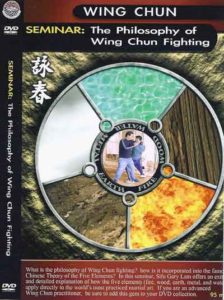The DVD “Five Element System” by Sifu Gary Lam is one the two more advanced topic Wing Chun DVDs in Sifu Lam’s growing Wing Chun DVD library (currently numbering fourteen titles). Wing Chun is different than other martial arts in that Wing Chun is concept based instead of technique based. Hence the “Five Element System” DVD covers a lot of theory and is a lengthy DVD at 95 minutes. Although there are some demonstrations of the concepts put forth, this DVD is more of a concept and theory DVD. Certainly the “Five Element System” has enough of the necessary demonstrations to illustrate some concepts, but this DVD is not like a Wing Chun empty-hand form DVD where each technique is followed by a demonstration. Sifu Lam utilizes five elements: water, wood, fire, earth and metal in a series of lists and matrices as well as a diagram to fully explain to the viewer a specific concept, how these concepts interrelate, how one element can aid another element, how one element can be used to overcome another element and how the five elements further conceptualize Wing Chun. As an example someone with fast hands (fire) can be overcome with changing (water) or distance (earth). This is not a DVD that will be easily digested in one sitting. There are so many fine points to understand that multiple viewings will likely be necessary for a Wing Chun practitioner to fully realize the content of this DVD and many of the elements are higher level. This DVD is highly recommended for the Wing Chun practitioner who wishes to advance his/her theoretical knowledge of Wing Chun, but is best suited for an advanced Wing Chun practitioner.
Sifu Gary Lam’s “Five Element System” DVD is much like the DVD “Fighting Strategy” (Wu Xing) because the DVD is oriented more towards theory with an occasional demonstration of ideas or concepts than straight forward demonstration. Certainly this DVD has sufficient demonstrations with one of Sifu Lam’s advanced students Peter Hsu (currently in Shanghai, China) than the “Fighting Strategy” DVD. However, theory must be presented before some of the finer points can be properly presented with a demonstration. The focus of the DVD is to illustrate the interlinkage of the concepts of the elements categorizing the whole Wing Chun system within the categories of the five elements.
Sifu Lam DVD breaks Wing Chun into the five elements, which also are divided into yin/yang. The five elements: water, wood, fire, earth, and metal are the five basic categories in which Wing Chun theory and concepts can be categorized and of course they are the same elements of ancient Chinese theory. Most cleverly explained and illustrated in both theory and demonstrations is the idea that in Wing Chun force should not be used to overcome force (a basic concept of Wing Chun). And once again control of the opponent is shown to be quite effective. Certainly if the chance presents itself the opponent should be hit, but the opponent can also be pulled (fire) into a punch, palm, elbow or kick, pushed (wood) completely out of the way, angled off (earth) to become ineffective, and shut down (damaged likened to metal).
Sifu Gary Lam being a long time student of the late Wong Shun Leung, brings to this DVD his Sifu’s vast beimo experiences as well as Sifu Lam’s own experiences in both combat and training. Many are the points presented in this DVD that are rarely explored elsewhere, such as “sitting” when an attack comes. There is in fact more than one level of sitting (there are four) as an attack progresses towards the Wing Chun practitioner. Given that Wing Chun takes power from the ground as an attack from the opponent presses forward sitting deeper gives the practitioner greater power (as seen in the Cham Kiu form and the Mook Yan Jong form).
During the course of the DVD Sifu Lam also goes on to state that that most Wing Chun students and even famous practitioners do not fully utilize the entire Wing Chun system, but a mere fraction that is around 20%, which is mostly crossing hands (likened to the element water). An example of this would be that most fighters today use only the angles of 0 degrees (straight on) or 60 degrees instead of the full: 0 degrees, 45 degrees, 60 degrees, 90 degrees and 120 degrees. The 90 degree angle is most effective, but Sifu Lam also states that to use the 90 degree angle takes a lot of practice to get to that level of proficiency. The angle of 120 is also quite effective, but again takes a lot of practice and can make the Wing Chun fighter lazy since the 120 angle is a finishing angle (Note the angle referred to as 120 is actually 180 degrees).
Through the course of the DVD Sifu Lam uses a diagram (which is also included with the DVD) to show the interrelation and negation of each element, a set of lists that form a matrix into which the elements are further divided, lists to detail Wong Shun Leung’s Wing Chun system (level one through four), and poster board cards illustrate each of those levels and then relates all of this to the five elements of ancient Chinese philosophy to the Wing Chun system. It should be remembered that Grandmaster Yip Man simplified Wing Chun and eliminated “mystical” elements as he progressed through the years refining his beloved art. Yip Man was of course a genius in Wing Chun.
During the course of the seminar Sifu Lam systematically breaks down each element into finer components. For example Wood has the finer points of: pushing, feeling, timing, maturity, experience and calmness during motion. Any individual element can be assisted or hindered by another element: for instance a fighter with fast hands (likened to fire), can be stopped by changing (likened to water) or distance (likened to earth). The DVD’s title may seem to be a bit abstract, but in fact the Wing Chun system does nicely break down into the five elements.
Wing Chun is martial art system for an intelligent fighter (Water – Wisdom, memory). Sifu Lam mentions that his own Sifu, Wong Shun Leung, had a great memory as well as keen intelligence, tremendous speed (Fire), superb timing (Wood) all the while seeming to be innocuous. And oh yes, like Bruce Lee, Wong was a great dancer. And all at a mere 90 lbs when Wong Shun Leung was challenge fighting back in the 50s and 60s defeating opponent after opponent with Wing Chun. These anecdotes of Wong Shun Leung serve to again reinforce the idea of Wing Chun as the science of in-fighting. Whoever the originators of the Wing Chun system were they certainly put a great deal of thought into this martial art as the “Five Elements” DVD demonstrates.
Wing Chun being a concept based martial art allows the system to well fit into the five element categorization. The seminar that Sifu Lam presents superbly covers the entire Wing Chun system and helps to clarify the finer points of the system. This DVD IS quite a bit longer than some of Sifu Lam’s other DVDs (95 minutes) due to the depth of the material needed to examine, in detail, the specifics of the five elements of the Wing Chun system. This DVD is really better suited for advanced students of Wing Chun, but someone who might decide to delve into the finer points of Wing Chun could certainly benefit. However, more advanced knowledge is a great help in digesting, understanding and utilizing this DVD.
Review by: Manuel Bustos
DVD Bought here: http://www.everythingwingchun.com/Gary-Lam-Philosophy-of-Wing-Chun-Fighting-p/gl02.htm

